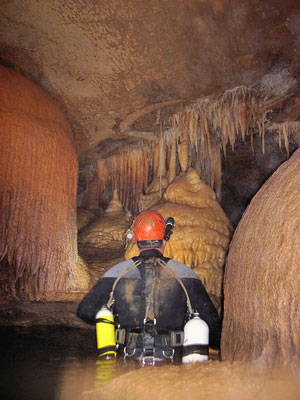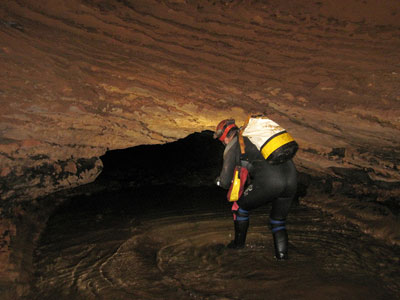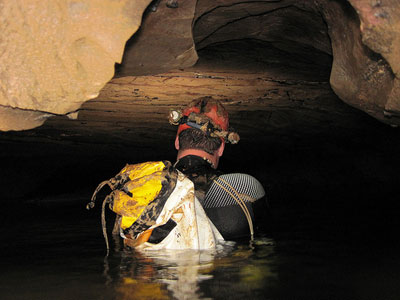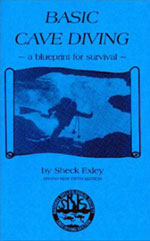| Exploration of the Elk River Streamway |
 |
| Written by Jim Arundale and Agnes Milowka |
| Sunday, 11 July 2010 17:11 |
|
In early 2006 a group of local cavers the Victorian Limestone Caving Team (VLCT) dug open an entrance to a cave that led down to a streamway, admittedly, not a large streamway, but flowing water none the less. At the time, on the Potholes Reserve in Buchan all the known caves dropped quite steeply to a level of impermeable chert resulting in the caves petering out. People had talked for years about the "Master Cave" that must exist in the next level of limestone beneath the chert, but nothing had gone through, until Elk River. The initial streamway that had been found ran for around 100m before terminating at both ends in sumps. Peter Freeman from the Victorian Speological Society (VSA) recounted the stories of the discovery to Jim Arundale and Agnes Milowka one evening after a day of caving in Buchan. As soon as Peter mentioned the word 'sump', their ears pricked up. A few weeks later they got to see the streamway and the sump for themselves and got rather excited. It looked like the sump would continue for at least a couple of meters. Excitement was heightened when it was discovered that the only dive had been done by a diver wearing back mounted tanks who reported the sump pinched out - the scene was set and a return planned.
The fun was not over for the day though and attention was turned to the upstream sump. This was passed after 4m and 10m of airspace was reached before the passage sumped again. This was investigated for about 12m to a point where lack of line, air & testosterone indicated a return, which was made in zero visibility. A few months later a return was made with two small cylinders and work began in earnest on the downstream sump. Inspired by another brief glimpse of the surface, the floor was scooped out by hand and pushed off to one side. Despite the disconcerting feeling that everything was slumping in behind him, progress was being made. After several minutes, an outstretched hand could just feel a vertical rise in the roof. Digging continued until finally one eye could just glimpse a large airspace continuing out of sight. After some more frantic digging, the rest of the head emerged, followed shortly afterwards by the rest of the body. The dive gear was quickly dropped and Jim skipped off down what was noticeably a much larger streamway. After several large chambers and a couple of very nice calcite waterfalls a large round chamber with a big pool was reached - yet another sump. Conscious of the time away and the prospect of a rather nasty dive back, exploration halted and Jim retraced his steps. The dive out was not one of the nicest, it took a couple of attempts, some serious digging and squeezing to get back out. One more solo trip was made in order to survey, but as the survey gear had flooded, the time was spent taking photographs and modifying the exit of the sump to try and make it self clearing, a little larger and hence a bit safer. The descent down to the actual water level is not all beer and skittles and getting to the sump is a trip in itself. It is not like diving in Mt Gambier where you drive up to a dive site, chuck on the tanks and take a leisurely stroll down stairs to the water. In Buchan, sherpa's are needed as they help drag the numerous bags filled with heavy diving equipment through the dry passage. The entrance to the Elk streamway is via Baby Berger cave and involves an abseil, a bit of laddering and plenty of crawling before you hit the water. One crawl in particular is, what can most politely be described as an absolute nuisance. Finally there are a couple of 'roof sniffs' in order to reach the sump itself. Roof sniffs are passages almost filled to the brim but not quite. The little bit of space in between the water and the ceiling means that you can negotiate it by floating on your back, nose to the ceiling, 'sniffing' the ceiling. Then, finally, you reach the first of the sumps to begin the diving.
The trip ended up being a hard 12 hour slog, yet was thoroughly enjoyed and treasured by the duo. The divers negotiated serious cave; low bedding planes, high rift passages, large chambers, rock falls and narrow rifts and some more tricky obstacles such as waterfalls and climbs. A couple of these climbs required some optimism and interesting acrobatics to free climb. Then there was the mud, deep and slippery and overlain with water, which made walking painful and strenuous when carrying dive gear. On the upside the cave was highly decorated with incredible formations such as flowstone, stalactites, stalagmites, rimstone pools and helictites and these distracted from the ardous conditions, albeit temporarily. On the way out the beautiful cobalt blue sumps resembled a mud bath and the divers were compelled to feel and grope their way out, as even their hands couldn't be seen on the line. All this certainly made for a very sporty and memorable trip. Jim and Ag returned four more times, lastly accompanied by Ken Smith and Mike Collins on a marathon 18 hours trip that combined surveying, photography and exploration at the far end of the cave. The end rift pitch was climbed only to discover two more sumps beyond. These sumps are deeper and longer, thus the team is faced with hauling ever-larger cylinders to the very back end of the cave in order to make continued progress through the 6m deep and 60m long sump 6. The second upstream sump was likewise pushed out to 60m, which led Ag to explore a much smaller and lower passage that after 50m, unsurprisingly, sumped yet again. Currently the streamway is over 1400m in length but a fair bit more caving & diving remains to be done in Elk in order to discover all its secrets.
While it is unlikely the cave diving in Victoria is ever going to take over from Tank cave and the easy stairs of Mt Gambier, there is water and diveable passage in Buchan and it is incredible stuff. Over the course of the exploration Jim and Ag had fabulous support. Without these folks, the exploration would have been virtually impossible. So a big thank you goes to Peter Freeman, Neil Wilson, Ian 'Chalky' Thomas, Miles and Daryl Pierce and Ted Matthews, Michael Collins and Ken Smith. |
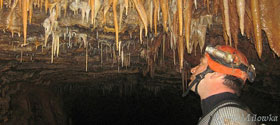 The Buchan area is one of the largest karst features in Victoria. It is a farming area like Mt Gambier but the landscape is very different. Here there are rolling hills and some reasonably sized rivers, although the flies remain the same. Underneath this landscape is a honeycomb of caves. The Pot Holes Reserve in particular is absolutely littered with them with over 90 caves known. Until recently all these caves were dry and there was no opportunity for diving.
The Buchan area is one of the largest karst features in Victoria. It is a farming area like Mt Gambier but the landscape is very different. Here there are rolling hills and some reasonably sized rivers, although the flies remain the same. Underneath this landscape is a honeycomb of caves. The Pot Holes Reserve in particular is absolutely littered with them with over 90 caves known. Until recently all these caves were dry and there was no opportunity for diving.